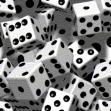Did Life Form By Accident?

Mathematical Probabilities
The next stop would be to delve into the mathematical probabilities that vastly complex organs such as the brain, the eyes, etc., could have developed by themselves. But before we begin, I’d like you to be able to fathom what the numbers that we will be giving you represent. It has been estimated that in 30 billion years there would only be 10^18 seconds. Scientists estimate that in our entire universe there are only 10^80 electrons (that’s a 1 with 80 zeros after it). So I guess we would agree that 10^100 is a number that’s pretty much impossible for us to truly comprehend. With this introduction, hopefully we’ll be able to properly appreciate the upcoming quotations.
Ilya Prigogine, chemist-physicist, recipient of two Nobel Prizes in chemistry, wrote: “The statistical probability that organic structures and the most precisely harmonized reactions that typify living organisms would be generated by accident, is zero.”(1) That’s right - zero!
Professor Francis Crick, awarded the Nobel Prize for the discovery of DNA, wrote:
An honest man, armed with all the knowledge available to us now, could only state that in some sense, the origin of life appears at the moment to be almost a miracle, so many are the conditions which would have had to have been satisfied to get it going.(2)
The trouble is that there are about two thousand enzymes, and the chance of obtaining them all in a random trial is only one part in (10^20)^2,000 = 10^40,000, an outrageously small probability that could not be faced even if the whole universe consisted of organic soup.(3) In terms of complexity, an individual cell is nothing when compared with a system like the mammalian brain. The human brain consists of about ten thousand million nerve cells. Each nerve cell puts out between ten thousand and one hundred thousand connecting fibers by which it makes contact with other nerve cells in the brain. Altogether the total number of connections in the human brain approaches 10^15 or a thousand million million. Numbers in the order of 10^15 are of course completely beyond comprehension. Imagine an area about half the size of the USA (one million square miles) covered in a forest of trees containing ten thousand trees per square mile. If each tree contained one hundred thousand leaves the total number of leaves in the forest would be 10^15, equivalent to the number of connections in the human brain! Despite the enormity of the number of connections, the ramifying forest of fibers is not a chaotic random tangle but a highly organized network in which a high proportion of the fibers are unique adaptive communication channels following their own specially ordained pathway through the brain. Even if only one hundredth of the connections in the brain were specifically organized, this would still represent a system containing a much greater number of specific connections than in the entire communications network on Earth.(4)
George Wald, leading evolutionist, wrote:
Organic molecules, therefore form a large and formidable array, endless in variety and of the most bewildering complexity. One cannot think of having organisms without them. This is precisely the trouble, for to understand how organisms originated we must first of all explain how such complicated molecules could come into being. And that is only the beginning. To make an organism requires not only a tremendous variety of these substances, in adequate amounts and proper proportions, but also just the right arrangement of them. Structure here is as important as composition - and what a complication of structural. The most complex machine man has devised - say an electronic brain - is child’s play compared with the simplest of living organisms. The especially trying thing is that complexity here involves such small dimensions. It is on the molecular level; it consists of a detailed fitting of molecule to molecule such as no chemist can attempt.(5)
Getting Very Desperate
We continue. After scientists discovered the vast complexities of the DNA code, and that these codes are to be found in even the most simple forms of life, they started to see “scary visions of a God.” Its massive complexities clearly pointed to a Great Designer, and that was no good. So they made up a new far-fetched theory which in essence was saying - we see that there must be a God, but we do not want to acknowledge Him, so we must place God somewhere else and are saying the following theory. However, before we tell you the “latest theory” we must first tell you that this theory is taken seriously by many in the scientific world, even though the ones that expounded it really didn’t believe it themselves. (We’ll speak about this shortly.) The second thing is, that you must know the credentials of the ones that said this theory, and they have great credentials. First, let’s hear a little about Sir Francis Crick. Sir Francis H.C. Crick, a noted biologist, is the one who deduced the double-helical structure of DNA, for which he, together with his partner James Watson, later received the Nobel Prize. Crick went on to contribute to the elucidation of the genetic code. In short, he is a very respected scientist. And what led Crick to give the following view was the feeling that it’s virtually impossible for the origin of life to have been undirected (accident). So Crick, together with noted chemist Leslie Orgel (who are trained scientists, who always look for naturalistic explanations to their problems - and to admit to a God wouldn’t be scientific) said the following wild theory. And mind you that this theory was proposed in 1973, and reaffirmed in 1983 when Crick wrote it in a book called Life Itself, and reaffirmed again in 1992 during an interview in Scientific American.(6)The wild theory is as follows. They say that some extraterrestrial civilization of another solar system, because of the fear of extinction, decided to “seed” other planets with the essence of their live matter. So they sent frozen bacteria out into space, and eventually it reached earth. While on earth, it was these live bacteria from outer space that evolved into life as we see it now. This is their theory. And this wild theory was necessary, since it helped explain a hurdle that couldn’t be made. They, as well as many other scientists, couldn’t explain how an inanimate object could turn into even the most simple of life forms, bearing in mind the vast complexities that are found in all life forms. So “necessity, the mother of all inventions” led them to make up this story, which supplied them with instant life, without having to recognize God. Pretty wild, huh? Really desperate. This is the theory of Drs. Francis Crick and Leslie Orgel.(7)Now you know what weight the word “theory” has.
But astronomer Sir Fred Hoyle, together with Chandra Wickramasinghe, in Evolution from Space, said that just as it’s impossible for life to have developed by chance in our solar system, so too there could never have developed intelligent life anywhere else in our entire universe as well. Hoyle wrote as follows: “Biochemical systems are exceedingly complex, so much so that the chance of their being formed through random shuffling of simple organic molecules is exceedingly minute, to a point where it is no different from zero ... For life to have originated on earth it would be necessary that quite explicit instructions should have ben provided for its assembly.”(8)So Hoyle tries to pull off an interesting trick. He says that really the theory of seeding (which in scientific terms is called panspermia) is correct, but of course there had to be a Higher Intelligence which created those outer space creatures that eventually sent down the seeds. So Hoyle, in order to avoid God, says the same far-fetched “theory” as crick and Orgel, in order to take care of the problem of having to meet up with this Higher Intelligence. Hoyle said that it’s the creatures from outer space that have the obligation to serve this Higher Intelligence, since it’s them who the Higher Intelligence created, and not us, so we earthlings have no obligation to serve Him. So even though Hoyle was at least scientifically honest, as was Crick, by agreeing that life could never have evolved from inorganic (dead) matter, he still wasn’t brave enough to face the God that he really admitted existed. But Newsweek couldn’t handle what Hoyle said, for ultimately, according to Hoyle, you still have to face a God somewhere at the top of the line, and this frightened them.
Tongue in cheek, Newsweek (March 1982) says only that “Hoyle has actually performed the improbable feat of reinventing religion ... [and had been] led to exactly the same view that seemed prevalent in the Middle Ages: that life did not arise spontaneously on earth.” Apparently, when Hoyle the scientist is led to God, Newsweek is irritated.(9)
As mentioned before, Crick confided to Professor Robert Shapiro(10)that he personally wasn’t really sold on the theory, and his real purpose in espousing this new theory was to get people to drop all previous theories that they held as true (such as the chemical soup theory, and the mutation theory, etc., all of them built on the idea that live matter can evolve from dead matter, which he held can’t be true) and give them an idea which they can relate to, such as unmanned rockets with live bacteria in them, to hold on to. Not that he really believed this story, but it was to help people understand that this world could only have developed from live matter. So even though in public Crick says that he still believes his theory to be “reasonable,” in private he told Shapiro otherwise.
Nothing illustrates more clearly just how intractable a problem the origin of life has become than the fact that world authorities can seriously toy with the idea of panspermia.(11)
Desperate people indeed. After hearing such “theories,” one sees the staunch loyalty these scientists have to “science,” for the sake of science. But it would be more honest if they would express more openly the problems that they face, and maybe, just maybe, suggest that there is an alternative solution to the origin of our universe - God.
Reprinted from BEYOND A REASONABLE DOUBT (click to order free copy)
Footnotes:
(1) I. Prigogine, N. Gregair, A. Babbyabtz, Physics Today 25, pp. 23-28.
(2) Crick, F., Life Itself, New York: Simon and Schuster, 1981, p.88.
(3) Evolution from Space, p.24.
(4) Evolution: A Theory in Crisis, p. 330.
(5) G. Wald, “The Origin of Life,” Scientific American, Vol. 191, No. 4.
(6) See Darwin’s Black Box, pp. 248-49; and The Obvious Proof, pp. 77-78.
(7) “Directed Panspermia,” Icarus, Vol. 19, 1973, p. 341.
(8) Evolution from Space, p. 30.
(9) The Obvious Proof, pp. 103-104.
(10) R. Shapiro, Origins: A Skeptic’s Guide to the Creation of Life on earth, New York: Bantam Books, 1986, pp. 227-228.
(11)Evolution: A Theory in Crisis, pp. 271.
Posted in: Jewish Beliefs & Philosophy



